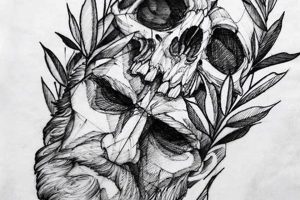Small, circular designs etched onto the skin offer a range of symbolic and aesthetic possibilities. These designs can represent commitment, eternity, strength, or simply personal style, often incorporating elements like bands, gemstones, initials, or significant dates. Examples include simple, unadorned bands mimicking traditional jewelry, or more intricate designs featuring intertwined patterns, natural imagery, or personalized inscriptions.
The enduring popularity of this form of body art stems from its versatility and discreetness. A small, circular design can be easily placed on fingers, toes, or even ears, offering a subtle yet powerful means of self-expression. Historically, finger adornments have signified status, affiliation, and belief systems across various cultures. This historical precedent lends further depth and meaning to contemporary circular body art.
Exploration of specific design motifs, placement options, and artistic styles provides a deeper understanding of this enduring art form. Considerations regarding symbolism, artist selection, and aftercare are also crucial for those considering such a permanent form of personal expression.
1. Placement (finger, toe, ear)
Placement constitutes a critical factor in ring tattoo design, profoundly impacting visibility, practicality, and overall aesthetic. Finger placement offers maximum visibility, showcasing the design prominently. This location, however, also presents challenges regarding wear and tear due to frequent hand use. Toe placement offers a more discreet option, suitable for designs intended for personal viewing or selective display. Ear placement, becoming increasingly popular, provides a unique and less conventional canvas for smaller, delicate ring-like designs. The chosen location directly influences the design’s longevity, requiring careful consideration of sun exposure, friction, and potential fading.
Practical considerations related to placement extend beyond mere visibility. Finger tattoos, for example, may pose challenges in professional environments with strict dress codes. Individuals engaged in manual labor might find finger tattoos impractical due to increased wear and tear. Conversely, toe tattoos offer greater protection from the elements and reduced exposure to daily wear, potentially increasing longevity. Ear tattoos present unique healing considerations due to the area’s delicate cartilage and limited blood flow. Consulting with a reputable tattoo artist is crucial for assessing suitability and potential risks associated with various placement options.
Careful consideration of placement ensures the ring tattoo remains aesthetically pleasing and practically manageable over time. Understanding the unique challenges and advantages associated with each location, alongside consultation with an experienced professional, contributes significantly to a successful and enduring piece of body art. Factors such as lifestyle, profession, and desired level of visibility should inform placement decisions, ultimately optimizing both the aesthetic and practical aspects of the chosen design.
2. Symbolism (love, commitment, eternity)
Symbolism plays a crucial role in ring tattoo designs, imbuing these small, circular markings with profound meaning. The unbroken circle represents eternity, infinity, and the cyclical nature of life, making it a potent symbol for enduring love and commitment. Representations of wedding bands, often incorporating initials, dates, or Roman numerals, serve as permanent declarations of love and partnership. Intertwined rings or knots further emphasize the unbreakable bond between two individuals. Beyond romantic love, ring tattoos can symbolize personal commitments to oneself, such as sobriety, personal growth, or dedication to a specific cause. The choice of symbols incorporated within the ring design, such as hearts, infinity symbols, or specific gemstones, adds layers of personal meaning and significance. For example, a serpent ring might represent transformation and renewal, while a feather could symbolize freedom and spiritual growth.
The enduring power of symbolic representation transforms a simple aesthetic choice into a deeply personal statement. Consider the historical significance of rings as symbols of power, authority, and belonging. Signet rings, bearing family crests or initials, historically denoted lineage and social standing. This historical context enriches the contemporary understanding of ring tattoos, adding depth and resonance to the chosen design. Practical applications of this symbolic significance manifest in the selection of specific imagery and its placement. A ring tattoo on the left ring finger carries distinct cultural connotations related to marriage, while a similar design on another finger might represent a different personal commitment. Careful consideration of symbolic meaning allows individuals to craft a tattoo that resonates deeply with their personal values and experiences.
Understanding the symbolic implications of ring tattoos ensures a meaningful and enduring piece of body art. While aesthetic considerations remain important, the chosen symbolism ultimately elevates the design from mere decoration to a powerful expression of personal identity and belief. Navigating the complexities of symbolic representation, however, requires careful research and thoughtful consideration. Consultation with experienced tattoo artists, familiar with various symbolic traditions and design elements, provides invaluable guidance in crafting a tattoo that authentically reflects the wearer’s intended meaning. This thoughtful approach ensures the chosen symbolism remains relevant and resonant throughout the individual’s life.
3. Design (bands, initials, patterns)
Design choices significantly impact the aesthetic and symbolic representation within ring tattoos. Simple bands, reminiscent of traditional jewelry, offer a classic, understated look, often chosen to symbolize commitment or eternity. Incorporating initials, dates, or Roman numerals adds a layer of personalization, transforming the design into a permanent memento of a significant relationship or event. More intricate patterns, such as Celtic knots, geometric designs, or floral motifs, introduce visual complexity and can represent cultural heritage, spiritual beliefs, or personal interests. The selection of specific design elements directly influences the tattoo’s overall style, ranging from minimalist and elegant to bold and expressive.
Consider the impact of design choices on the final result. A thin, delicate band might convey understated elegance, while a thicker, bolder band could represent strength and resilience. Intertwined bands or knots symbolize unity and connection, particularly relevant for relationship-themed tattoos. Incorporating birthstones or other gemstones adds symbolic meaning related to specific months or personal characteristics. Practical considerations also influence design choices. Highly detailed designs might require larger surface areas, potentially limiting placement options. Simpler designs, conversely, offer greater flexibility in terms of placement and size.
Careful consideration of design elements ensures the ring tattoo aligns with individual preferences and intended meaning. Design choices impact not only the tattoo’s appearance but also its symbolic resonance and practical feasibility. Balancing aesthetic appeal with personal significance and practical limitations leads to a well-executed and meaningful piece of body art. Consulting with experienced tattoo artists, proficient in various design styles, provides valuable insights and helps individuals navigate the diverse options available, ultimately resulting in a design that reflects personal style and intended symbolism effectively.
4. Size and width
Size and width constitute critical design elements in ring tattoos, significantly influencing the final aesthetic and practical implications. These dimensions directly impact the tattoo’s visibility, detail complexity, and overall balance in relation to the chosen placement. A delicate, thin band, for example, might appear elegant and understated on a slender finger, whereas a thicker band could overwhelm the same area. Conversely, a broader band might be necessary on a larger finger to achieve visual balance and prevent the tattoo from appearing disproportionately small. The chosen size and width also affect the longevity of the tattoo. Thinner lines tend to fade and blur more quickly over time, especially in high-friction areas like fingers, while thicker lines generally retain their definition longer.
Practical considerations related to size and width extend beyond mere aesthetics. Intricate details and complex patterns necessitate a larger surface area, potentially limiting placement options. Smaller, simpler designs, conversely, offer greater flexibility regarding placement and accommodate the anatomical limitations of certain areas like fingers and toes. Professional considerations also play a role. Individuals in professions with strict dress codes might opt for smaller, less conspicuous designs, while those in more creative fields might embrace bolder, more prominent tattoos. Consider the example of a musician who might choose a wider band incorporating musical notes or symbols, contrasting with a minimalist, thin band preferred by someone seeking a subtle representation of commitment.
Careful consideration of size and width ensures the ring tattoo remains aesthetically pleasing, practically appropriate, and symbolically resonant. Balancing these dimensions with design complexity, placement, and individual lifestyle factors contributes to a successful and enduring piece of body art. Consultation with an experienced tattoo artist provides invaluable guidance regarding appropriate size and width choices, taking into account individual anatomy, design preferences, and practical limitations. This collaborative approach optimizes the balance between aesthetics, practicality, and personal significance, ultimately resulting in a tattoo that fulfills the wearer’s vision and stands the test of time.
5. Color and shading
Color and shading significantly impact the aesthetic depth and symbolic representation of ring tattoos. These elements enhance the visual impact of chosen designs, ranging from subtle monochromatic gradients to vibrant, multi-colored displays. Skilled application of color and shading creates dimension, texture, and visual interest, transforming simple linework into dynamic, eye-catching pieces of art. Careful consideration of color palettes and shading techniques ensures the final result aligns with individual preferences and intended symbolism.
- Monochromatic Realism
Utilizing black ink and subtle grayscale shading, monochromatic realism achieves a classic, timeless aesthetic. This technique emulates the appearance of traditional jewelry, lending an air of sophistication and understated elegance to ring tattoo designs. Fine line details and subtle shading create depth and dimension, mimicking the interplay of light and shadow on metallic surfaces. This approach suits individuals seeking a discreet yet impactful design, resembling a finely crafted piece of jewelry.
- Vibrant Color Palettes
Incorporating vibrant colors expands the range of artistic expression in ring tattoos. Bold color choices, ranging from jewel tones to pastel hues, imbue designs with personality and vibrancy. This approach allows for greater creativity in representing symbolic elements, such as birthstones, flowers, or other meaningful imagery. A vibrant color palette can transform a simple band into a striking visual statement, reflecting individual style and preferences. However, color vibrancy can fade over time, requiring touch-ups to maintain the desired intensity.
- Watercolor Effects
Watercolor-style shading introduces a soft, diffused aesthetic to ring tattoos. This technique creates a dreamlike, artistic impression, often incorporating gradients and blends of color. The fluid, ethereal quality of watercolor shading lends itself well to designs featuring floral motifs, abstract patterns, or other organic imagery. This style offers a less defined, more artistic approach compared to traditional shading techniques, adding a unique visual texture to ring tattoo designs.
- Symbolic Color Choices
Color choices in ring tattoos often carry symbolic meaning, adding depth and complexity to the design. Specific colors hold cultural and personal significance, enhancing the narrative conveyed by the tattoo. Red, for example, can represent love and passion, while blue might symbolize tranquility and loyalty. Green often signifies growth and renewal, while black represents strength and resilience. Incorporating symbolic color choices transforms the ring tattoo into a powerful personal statement, reflecting individual values and beliefs.
Color and shading choices significantly influence the final aesthetic and symbolic representation of ring tattoos. Understanding the impact of various techniques and color palettes empowers individuals to make informed decisions, ensuring the final result aligns with personal style and intended meaning. Consultation with a skilled tattoo artist, experienced in various color and shading techniques, ensures a well-executed and enduring piece of body art that reflects individual preferences and symbolic intentions effectively.
Tips for Ring Tattoo Designs
Careful planning ensures successful and meaningful ring tattoo designs. Consideration of practical and aesthetic factors contributes to a satisfying, long-lasting piece of body art.
Tip 1: Research Thoroughly: Explore various design styles, symbolism, and placement options before committing to a design. Review portfolios of reputable tattoo artists specializing in fine linework and small-scale designs.
Tip 2: Prioritize Placement: Consider visibility, practicality, and potential wear and tear associated with different placement options (fingers, toes, ears). Evaluate lifestyle factors and professional considerations when selecting a location.
Tip 3: Size Matters: Choose appropriate size and width based on the chosen design, placement, and individual anatomy. Thinner lines might appear delicate but fade more quickly, especially on fingers. Larger designs require more surface area.
Tip 4: Symbolic Resonance: Infuse the design with personal meaning through symbolic elements, such as initials, dates, or specific patterns. Research symbolic connotations to ensure the chosen elements align with intended meaning.
Tip 5: Color Considerations: Evaluate the impact of color and shading on the overall design. Monochromatic designs offer a classic look, while vibrant colors add personality. Consider potential fading and the need for touch-ups over time.
Tip 6: Consult a Professional: Discuss design ideas, placement options, and potential risks with a reputable tattoo artist. A professional consultation ensures the chosen design is both aesthetically pleasing and practically feasible.
Tip 7: Aftercare is Crucial: Follow aftercare instructions diligently to ensure proper healing and prevent infection. Proper aftercare preserves the vibrancy and longevity of the tattoo.
Careful consideration of these factors ensures a ring tattoo remains a source of personal satisfaction for years to come. Proper planning, professional consultation, and diligent aftercare contribute to a well-executed, meaningful, and enduring piece of body art.
By following these tips, individuals can confidently navigate the process of selecting and implementing a ring tattoo design that reflects personal style, symbolic significance, and practical considerations effectively.
Frequently Asked Questions about Ring Tattoos
This section addresses common inquiries regarding ring tattoos, offering factual information and practical guidance.
Question 1: How painful are ring tattoos?
Pain levels vary based on individual pain tolerance and the specific location. Fingers and toes possess a higher concentration of nerve endings, potentially increasing sensitivity. Ears, due to cartilage, may also present higher discomfort levels.
Question 2: How long do ring tattoos last?
Longevity depends on factors such as placement, ink quality, aftercare, and individual skin characteristics. Finger tattoos, due to frequent hand use and exposure, may require more frequent touch-ups compared to tattoos in less exposed areas. Proper aftercare significantly contributes to long-term vibrancy.
Question 3: Can ring tattoos be removed?
Laser removal remains the most effective method for removing tattoos, including ring tattoos. Multiple sessions may be required, and complete removal is not always guaranteed. Small, faded tattoos are generally easier to remove than larger, more saturated designs.
Question 4: Are there any risks associated with ring tattoos?
All tattoos carry inherent risks, including infection, allergic reactions, and scarring. Finger tattoos, due to their location, possess an increased risk of infection if not cared for properly. Consulting with a reputable, licensed tattoo artist minimizes these risks.
Question 5: What is the typical cost of a ring tattoo?
Costs vary based on factors such as design complexity, size, artist experience, and geographic location. Simpler designs generally cost less than intricate, multi-colored tattoos. Researching local tattoo studios and requesting quotes provides a realistic cost estimate.
Question 6: How should one choose a tattoo artist for a ring tattoo?
Selecting an experienced artist specializing in fine linework and small-scale designs is crucial. Reviewing artist portfolios, checking licenses and certifications, and consulting previous clients ensures a safe and satisfactory experience.
Thorough research and professional consultation mitigate potential risks and maximize the likelihood of a successful and satisfying ring tattoo experience. Addressing these common concerns empowers individuals to make informed decisions, ensuring a positive outcome aligned with personal preferences and expectations.
Further research regarding specific design elements, artist selection, and aftercare procedures ensures a comprehensive understanding of the process and contributes to a positive and enduring result.
Conclusion
Exploration of permanent circular skin adornments reveals a diverse range of aesthetic and symbolic possibilities. Placement, design complexity, size, color, and symbolism intertwine to create deeply personal expressions of identity, commitment, or remembrance. Careful consideration of these elements, alongside practical factors such as longevity and aftercare, ensures successful execution and lasting satisfaction. Professional consultation with experienced artists remains paramount in navigating the complexities of design choices and placement considerations, ultimately contributing to a well-executed and meaningful piece of body art.
Permanent skin art represents a significant personal commitment. Thorough research, thoughtful design selection, and meticulous execution elevate these small, circular emblems beyond mere aesthetics, transforming them into powerful symbols of personal narratives and enduring values. The enduring popularity of this art form underscores its capacity for profound personal expression and its potential to encapsulate significant life moments and enduring personal beliefs within a timeless, elegant form.







